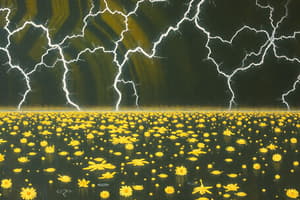Podcast
Questions and Answers
What is the source of the word 'electricity'?
What is the source of the word 'electricity'?
- The Greek word for electric charges
- The Greek word for amber, ἤλεκτρον (ḗlektron) (correct)
- The classical understanding of electric charges
- The word 'amber' in Latin
What is the branch of physics that studies slow-moving or stationary electric charges?
What is the branch of physics that studies slow-moving or stationary electric charges?
- Thermodynamics
- Kinematics
- Electrostatics (correct)
- Optics
Which law describes the forces between electric charges?
Which law describes the forces between electric charges?
- Faraday's law
- Ohm's law
- Coulomb's law (correct)
- Newton's law
What are examples of electrostatic phenomena mentioned in the text?
What are examples of electrostatic phenomena mentioned in the text?
What plays a very large role in how atoms and molecules behave at small scales?
What plays a very large role in how atoms and molecules behave at small scales?
What is more than 39 orders of magnitude stronger than the gravitational force at the nanoscale?
What is more than 39 orders of magnitude stronger than the gravitational force at the nanoscale?
What is the SI unit of electric field?
What is the SI unit of electric field?
What happens to the electrostatic force between two charges if the distance between them is doubled?
What happens to the electrostatic force between two charges if the distance between them is doubled?
What is the value of the Coulomb constant, ke?
What is the value of the Coulomb constant, ke?
What is the vacuum permittivity, ε0, approximately equal to?
What is the vacuum permittivity, ε0, approximately equal to?
What is the electric field, E→, defined as?
What is the electric field, E→, defined as?
What are electric field lines parallel to at each point?
What are electric field lines parallel to at each point?
What do electric field lines begin on and terminate on?
What do electric field lines begin on and terminate on?
How is the electric field defined at the location of point charges?
How is the electric field defined at the location of point charges?
What is the force F→q due to the electric field E→ on a charge q?
What is the force F→q due to the electric field E→ on a charge q?
What does the density of electric field lines represent?
What does the density of electric field lines represent?
Flashcards are hidden until you start studying
Study Notes
Origin and Study of Electricity
- The word 'electricity' originates from the Greek word "ēlektron," meaning amber, known for producing static electricity when rubbed.
- Electrostatics is the branch of physics that investigates slow-moving or stationary electric charges.
Fundamental Principles
- Coulomb's Law describes the forces between electric charges, quantifying the electrostatic interaction.
- Common examples of electrostatic phenomena include lightning, static cling, and the repulsion or attraction between charged objects.
Atomic and Molecular Behavior
- Electrostatic interactions significantly influence how atoms and molecules behave at small scales.
- These interactions are over 39 orders of magnitude stronger than gravitational forces at the nanoscale.
Measurement Units
- The SI unit of the electric field is volts per meter (V/m).
Distance and Force Relationship
- When the distance between two charges is doubled, the electrostatic force between them decreases by a factor of four.
Constants in Electrostatics
- The value of the Coulomb constant (ke) is approximately 8.99 x 10^9 N m²/C².
- The vacuum permittivity (ε0) is roughly equal to 8.85 x 10^-12 F/m.
Electric Field Defined
- The electric field (E→) is defined as the force experienced per unit charge at a point in space.
- Electric field lines are parallel at each point and visually represent the direction and strength of the field.
Behavior of Electric Field Lines
- Electric field lines begin on positive charges and terminate on negative charges, indicating the direction of the force on positive test charges.
Point Charges and Electric Field
- The electric field is defined at the location of point charges based on the force they exert on other charges placed within the field.
- The force F→q on a charge q due to the electric field E→ is given by the equation F→q = qE→.
Representation of Electric Field Density
- The density of electric field lines represents the strength of the electric field—closely packed lines indicate a stronger field, while sparse lines indicate a weaker field.
Studying That Suits You
Use AI to generate personalized quizzes and flashcards to suit your learning preferences.




